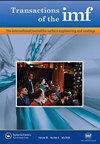Effect of superimposed sinusoidal A.C. on the characteristics of electrodeposited Ni, Cu and Cu-Ni alloy composites with α-Al2O3 and TiO2
IF 1.5
4区 材料科学
Q4 ELECTROCHEMISTRY
Transactions of The Institute of Metal Finishing
Pub Date : 1998-01-01
DOI:10.1080/00202967.1998.11871222
引用次数: 3
Abstract
Nickel, copper and copper-nickel alloy composites were electrodeposited without and with inclusions of inert α-Al 2 O 3 and TiO 2 particles from closely similar selected baths. It was found that during electrodeposition a superimposed sinusoidal a.c. exerted a decrease in the cathodic polarization for the individual metals and the alloy composites. The higher the superimposed a.c. density and the lower its frequency the greater was the depolarizing effect. The combined effect of superimposed a.c. and inclusion of the inert particles in the bath on the cathodic polarization proved to be additive. Superimposed a.c. induced negligible changes in the cathodic current efficiency of nickel and copper metal composites deposition, whereas it caused a marked decrease (about 20%) in that of the copper-nickel alloy composites. The inert (α-Al 2 O 3 and TiO 2 ) particles content in the individual metal and alloy composites as well as the alloy composition were influenced by the superimposed a.c. and correlated with its depolarizing effect. The above-mentioned changes exerted by superimposed a.c. controlled the growth morphology, as revealed by SEM, and the microhardness of the as-deposited metal and alloy composites. A correlation could be detected between superimposed a.c. and dispersion of α-Al 2 O 3 or TiO 2 particles in an individual metal or alloy matrix, the grain refinement, and an improvement of its microhardness could be detected.叠加正弦交流对α-Al2O3和TiO2电沉积Ni、Cu及Cu-Ni合金复合材料性能的影响
镍、铜和铜镍合金复合材料的电沉积不含α- al_2o_3和tio2的夹杂物。结果表明,在电沉积过程中,叠加的正弦交流电使单个金属和合金复合材料的阴极极化减小。叠加的交流密度越高,频率越低,去极化效果越明显。叠加的交流电和熔池中惰性粒子的加入对阴极极化的影响是叠加的。叠加交流对镍铜金属复合材料阴极电流效率的影响可以忽略不计,而对铜镍合金复合材料阴极电流效率的影响则显著降低(约20%)。复合材料中惰性粒子(α- al2o3和tio2)的含量及合金成分均受叠加交流电的影响,并与复合材料的去极化效应相关。SEM显示,复合材料的生长形貌和显微硬度受叠加交流电的影响。α- al_2o_3或tio2颗粒在单个金属或合金基体中的分散、晶粒细化和显微硬度的提高与叠加交流电之间存在相关性。
本文章由计算机程序翻译,如有差异,请以英文原文为准。
求助全文
约1分钟内获得全文
求助全文
来源期刊

Transactions of The Institute of Metal Finishing
工程技术-材料科学:膜
CiteScore
3.40
自引率
10.50%
发文量
62
审稿时长
3 months
期刊介绍:
Transactions of the Institute of Metal Finishing provides international peer-reviewed coverage of all aspects of surface finishing and surface engineering, from fundamental research to in-service applications. The coverage is principally concerned with the application of surface engineering and coating technologies to enhance the properties of engineering components and assemblies. These techniques include electroplating and electroless plating and their pre- and post-treatments, thus embracing all cleaning pickling and chemical conversion processes, and also complementary processes such as anodising. Increasingly, other processes are becoming important particularly regarding surface profile, texture, opacity, contact integrity, etc.
 求助内容:
求助内容: 应助结果提醒方式:
应助结果提醒方式:


